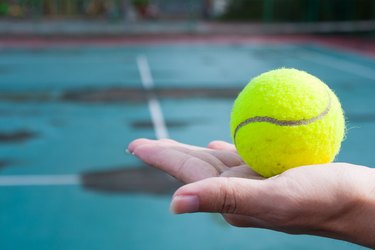
Wondering if you need to add a gyro ball to your workout routine? Gyroscope hand exercisers are advertised as fitness tools that help condition your wrist and improve grip, forearm and even finger strength. Some also claim to assist with rehab for conditions like carpal tunnel and arthritis.
Tip
A gyro ball is a type of gyroscope hand exerciser that may help with building hand, forearm and wrist strength.
Video of the Day
What Is a Gyro Ball?
Online, these products go by several names, including gyro ball, Powerball and Dynaflex ball. While the names may vary, these products, in general, are marketed as a way to strengthen muscles in the forearms, wrists and hands. Some also claim to target muscles in your arms and shoulders.
Video of the Day
They come in the shape of a small ball and can fit in the palm of your hand. The outside of the ball is easy to grip and typically made of plastic. Inside the ball, you'll find the gyroscope, which makes the ball spin with power.
As you grip the ball and move your forearm and wrists, the ball will begin to spin. Increase your movements, and the ball will spin faster in its shell.
Read more: Benefits of Hand Grip Exercises
Do They Work?
The theory behind these trainers makes sense, especially when you consider how important it is to maintain grip strength as you age and for specific sports. The only problem is there is minimal research on the use of these products and, more specifically, scientific studies on using a gyro ball.
One small study published in April 2016 in the Journal of Biology of Exercise evaluated the effectiveness of the PowerBall and the Shake Weight as training protocols for arm strength in females. For 18 days, they asked the participants to do arm-specific exercises using one of the two pieces of equipment. At the end of the 18 days, the researchers found some improvement in grip strength in both groups, which led them to justify the effectiveness of the training.
But finding an abundance of research or studies on the effectiveness of these balls is not likely. The good news? There are other ways to work those particular muscles.
Read more: Gyro Ball Exercises
Forearm and Grip Strength
Athletes who require grip strength, such as rock climbers and baseball players, often do specialized exercises to target the muscles in the forearms, wrists and hands. Unfortunately, not everyone includes this type of training in their routine. And as an October 2016 study in the Journal of Hand Therapy found, grip strength is on the decline, especially in men younger than 30.
Researchers discovered that compared with their counterparts in 1985, guys today are weaker when it comes to their grip and hand function. While the normative data is from 1985, the authors did point out that it is an interesting discovery that this group of males have statistically lower strength scores than men the same age in 1985.
According to the American Council on Exercise, strength training exercises that target grip and forearm function are often left out of workout routines. To help with daily activities such as opening and closing jars, and athletic skills like gripping a ball, climbing a wall or lifting weights, they recommend adding one or two hand exercises to every workout.
Some excellent choices include reverse curls with a barbell or set of dumbbells and the farmer's walk carrying weight plates or ball squeezes. If you have a tennis ball at home, the National Institute on Aging at NIH recommends squeezing the ball in each hand 10 to 15 times. With each squeeze, hold the ball for three to five seconds before releasing the pressure and squeezing again.
- Journal of Hand Therapy: "Comparative Study of Millennials (Age 20-34) Grip and Lateral Pinch With the Norms"
- American Council on Exercise: "How to Improve Grip Strength"
- Journal of Biology of Exercise: "Evaluation of Strength Training Protocols With the Use of the Powerball and Shakeweight in Moderate Trained Women"
- National Institute on Aging at NIH: "Hand Grip Strength Exercise"